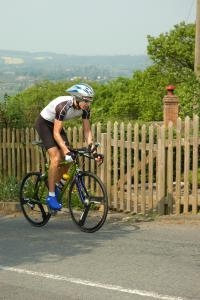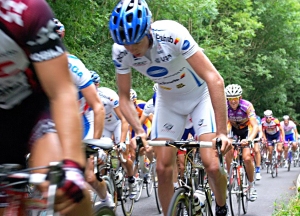|
The Jack Clements Memorial Little Mountain
Time Trial
The Hill Climbs
 |
|
Daniel Soltys (Wrekinsport
CC)
2007 hill-climbs winner
|
Beacon RCC's Little Mountain Time Trial isn't quite what
its name might suggest: there aren't any mountains. But, on
your way round a course that tests just about every skill
a racing cyclist should aspire to, you'll come across several
hills that you won't forget in a hurry. Two of them - Stanford
Bank and Ankerdine Hill - are individually timed, and there
is a special prize for the fastest aggregate hill climb performance.
Stanford Bank
Stanford Bank is a steep section of road midway up the longest
climb on the course. After crossing the Teme at Stanford Bridge,
nearly 20 miles into the race, the westbound B4203 begins
to climb. The ascent is quite gentle at first, rising toward
the hillside church where Jack Clements himself has his memorial.
But as the church draws near, the road straightens out and
Stanford Bank stretches up to its full height before you.
The timed section is 17% and about 0.6 miles long: most of
it dead straight, with woodland on either side, before swinging
left, shortly before the timekeeper's station. One of the
toughest things about Stanford is that the top of the bank
doesn't actually mark the end of the climbing: the road continues
to go up all the way the Upper Sapey crossroads, another mile
along the course. Anyone who digs a little too deep on the
bank pays dearly on the false flat that follows.
Bottom timing point: Public footpath/bridleway sign in
gateway just after turn to Orleton
Top timing point: BT cover on uphill side of gated track
Ankerdine Hill
 |
|
Tour of Britain peloton
climbing Ankerdine Hill on 12th September 2007
|
Ankerdine isn't nearly as long as the climb from Stanford
Bridge to Upper Sapey, and only briefly matches the first
hill climb's gradient. Yet many competitors find it every
bit as tough. That has a lot to do with where it comes in
the race. More than 33 demanding miles have been covered before
the riders swing north off the eastbound A44 to tackle Ankerdine.
That means over one-hour-twenty for the best … and more like
one-forty for most. What's more, the climb comes immediately
after the quickest section of the whole course: the sweeping
descent from Bromyard Downs and a couple of fast miles along
the Teme Valley floor. The abrupt change asks a great deal
of a racer's physical and mental strength. But it would be
quite wrong to suggest that Ankerdine just seems tough
to tired riders. Climbing it at speed is demanding at any
time. For one thing, the hill is preceded by a sharp right-hander,
which means you start the climb with very little momentum.
Then the gradient constantly changes, making it hard to find
a rhythm or even settle on a gear. The steepest section is
over by the time you reach Sunningdale, about halfway up.
But the suffering certainly isn't. The gradient repeatedly
eases just enough to offer the tantalising prospect of respite,
which disappears before you can touch it. The wooded 0.7-mile
climb ends with a left-hand bend, through a cluster of whitewashed
houses at the summit. The 2007 Tour of Britain came to Worcestershire
and climbed the famous ascent of Ankerdine. For a bit of fun
we timed the lead group as they climbed Ankerdine and have
compared their time with the fastest times recorded in the
Little Mountain TT [details].
Bottom timing point: Signpost opposite Church - the one
nearest to the Church gate
Top timing point: Cats-eye nearest to south gatepost (left
hand post looking from road) of Hayword House
|